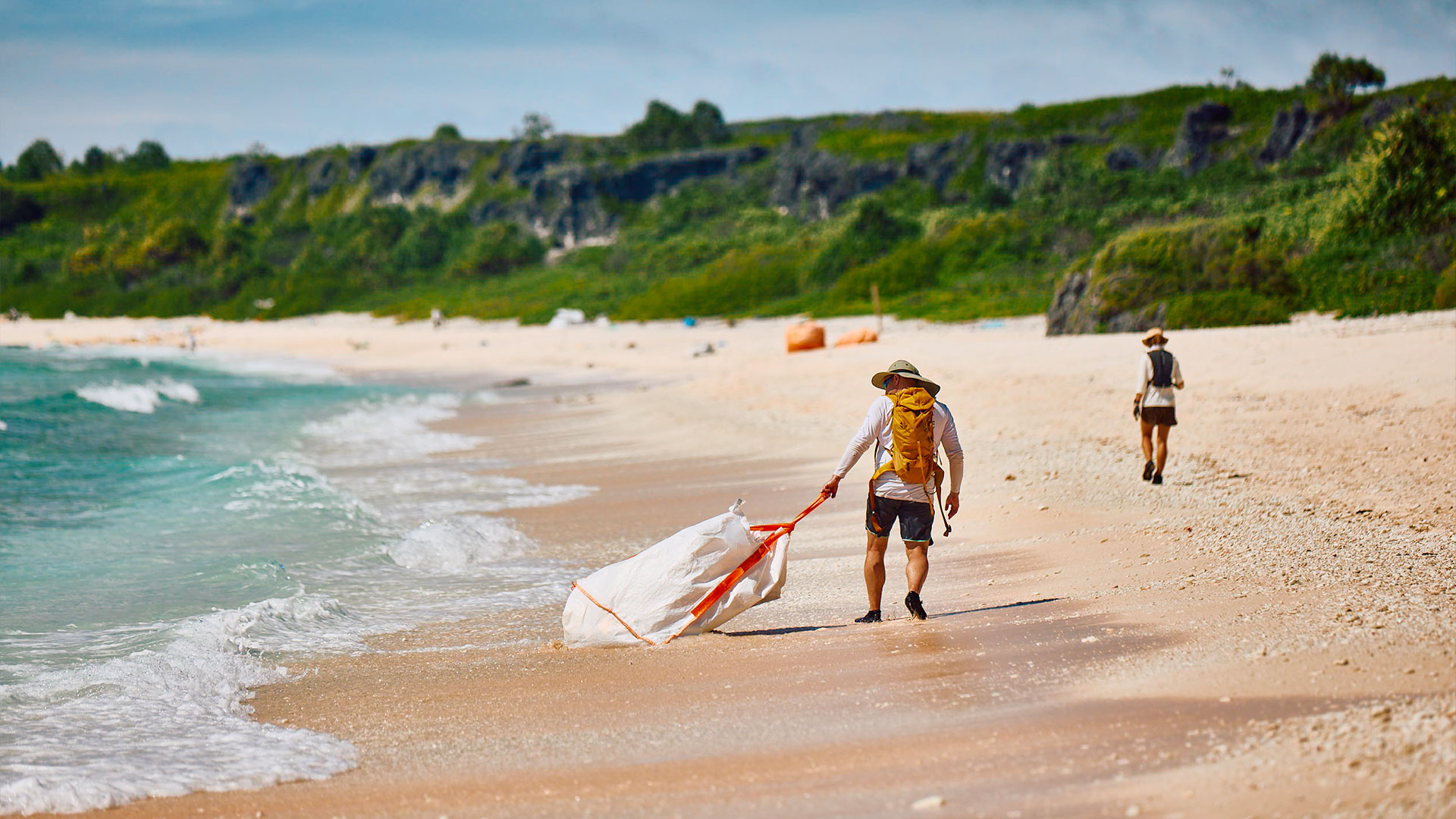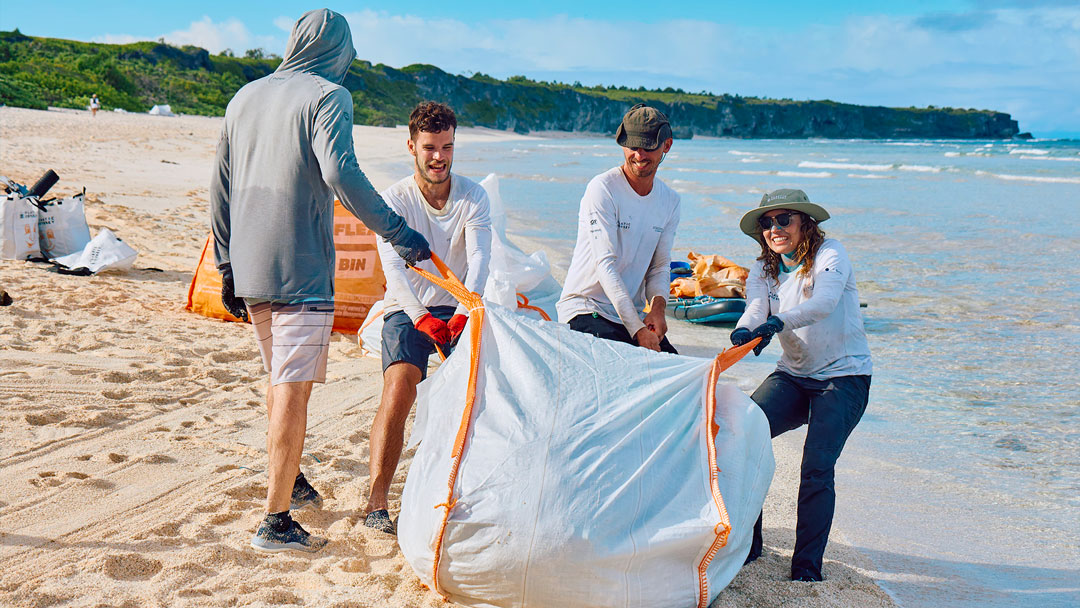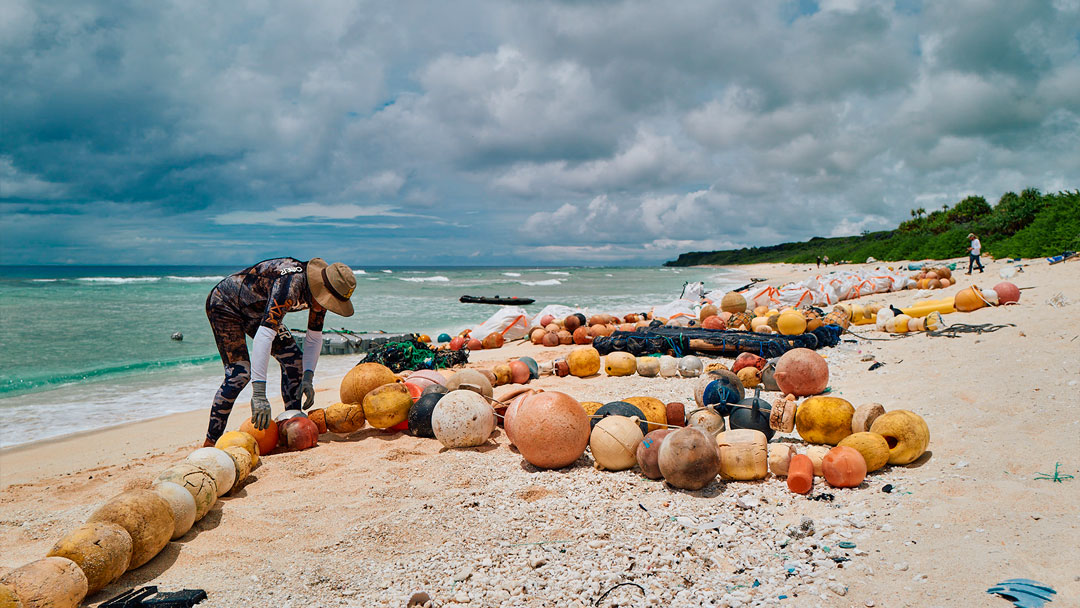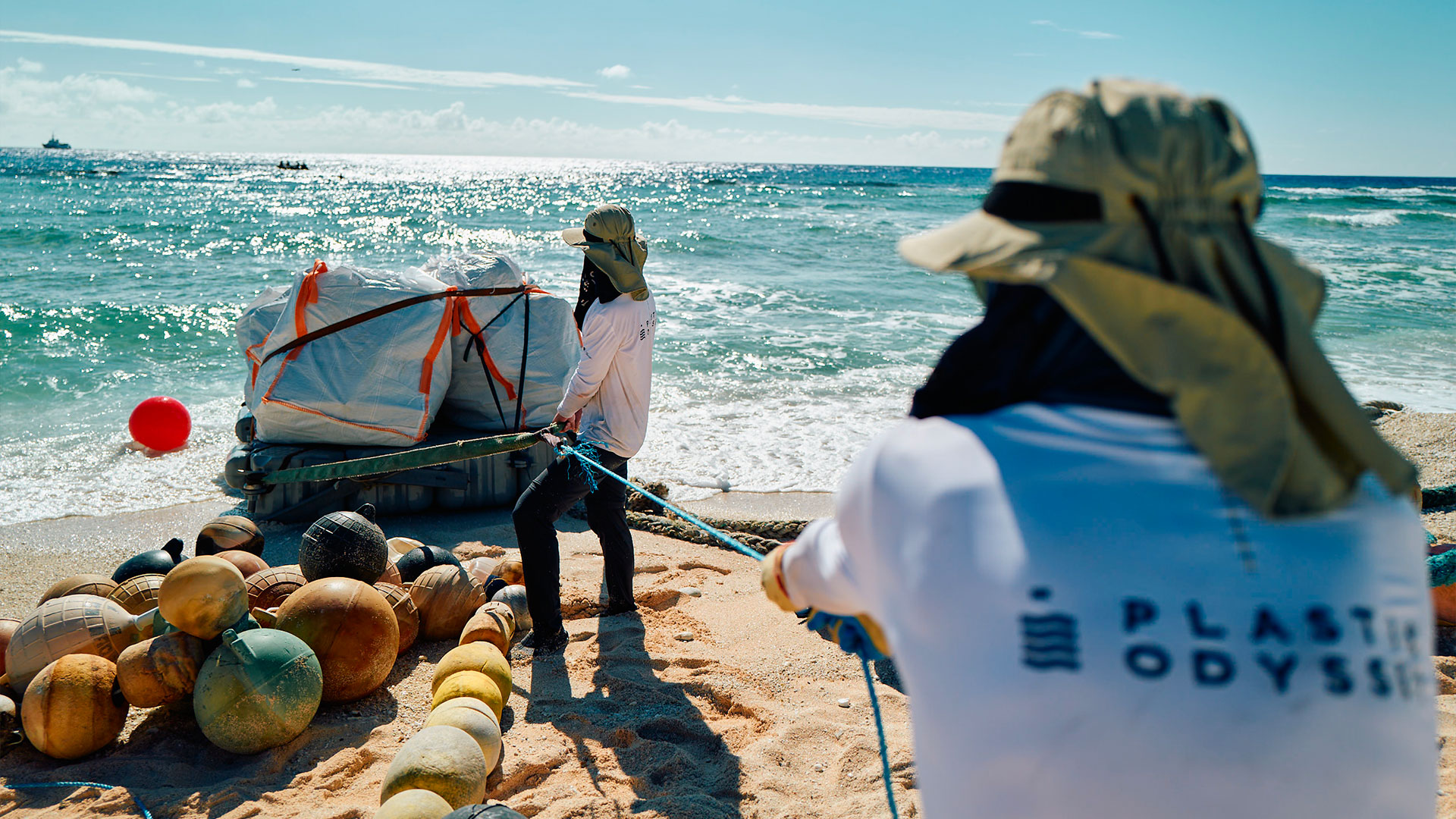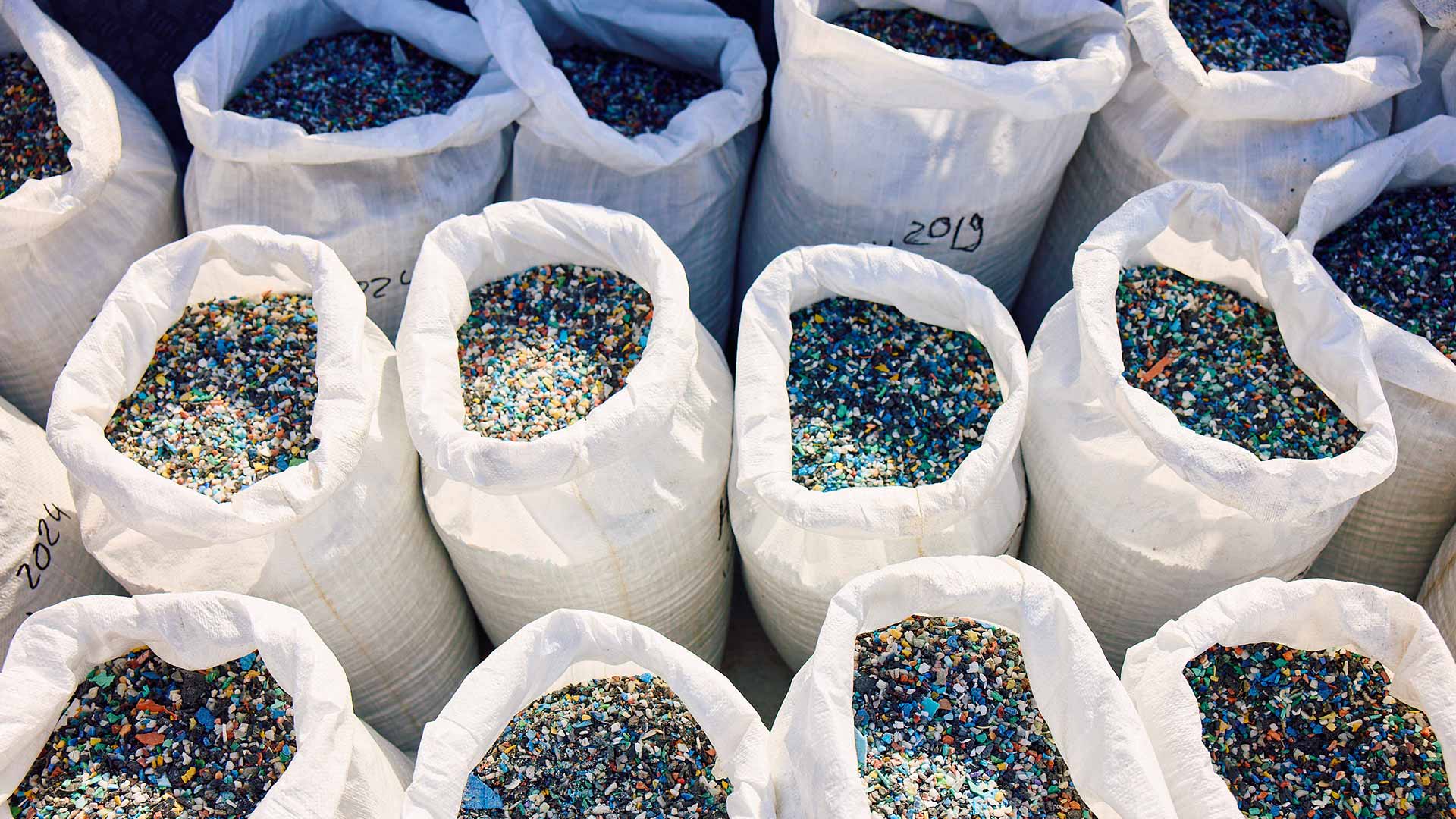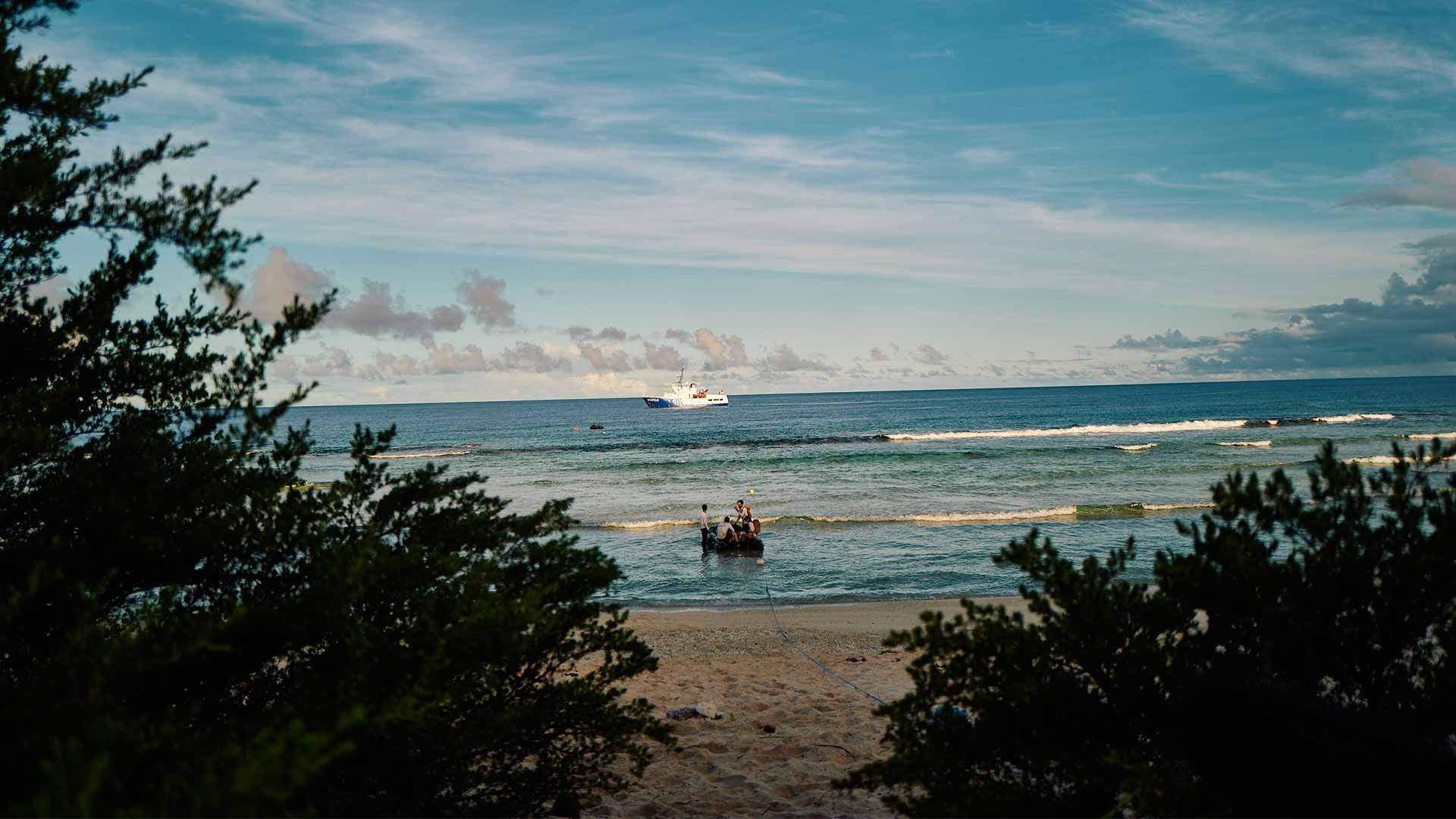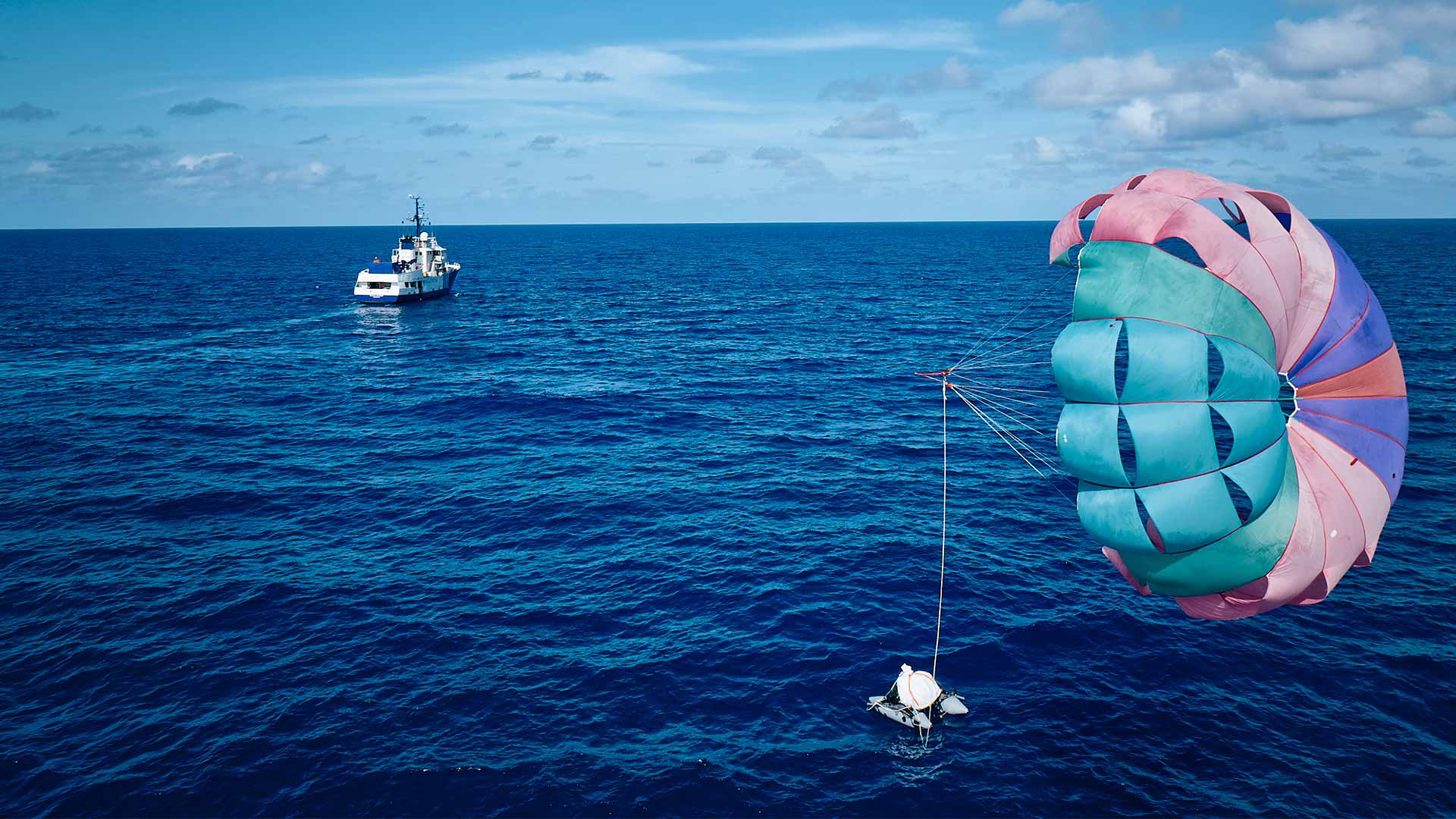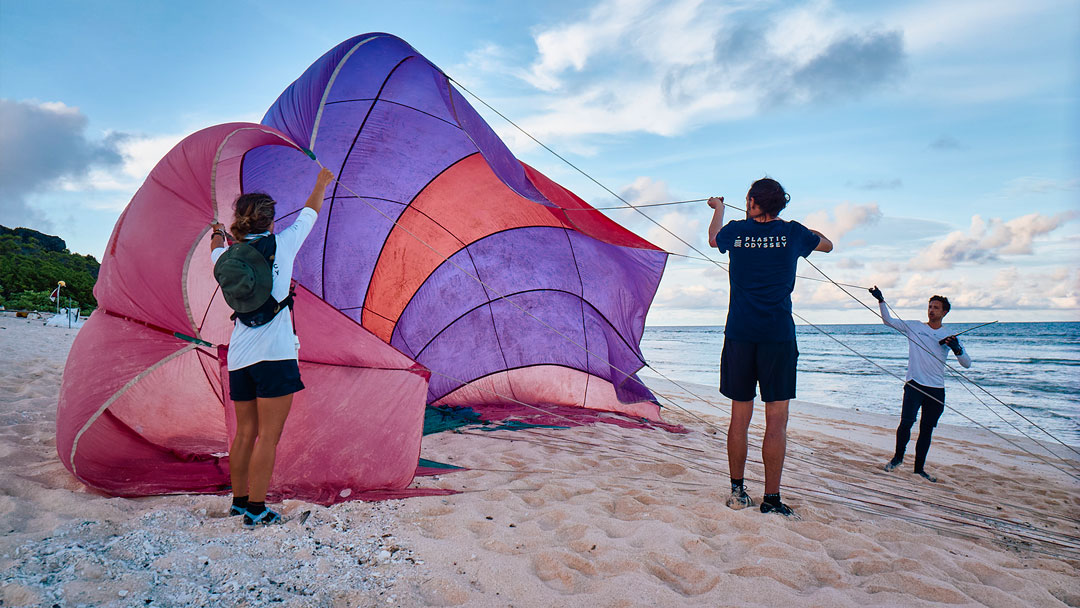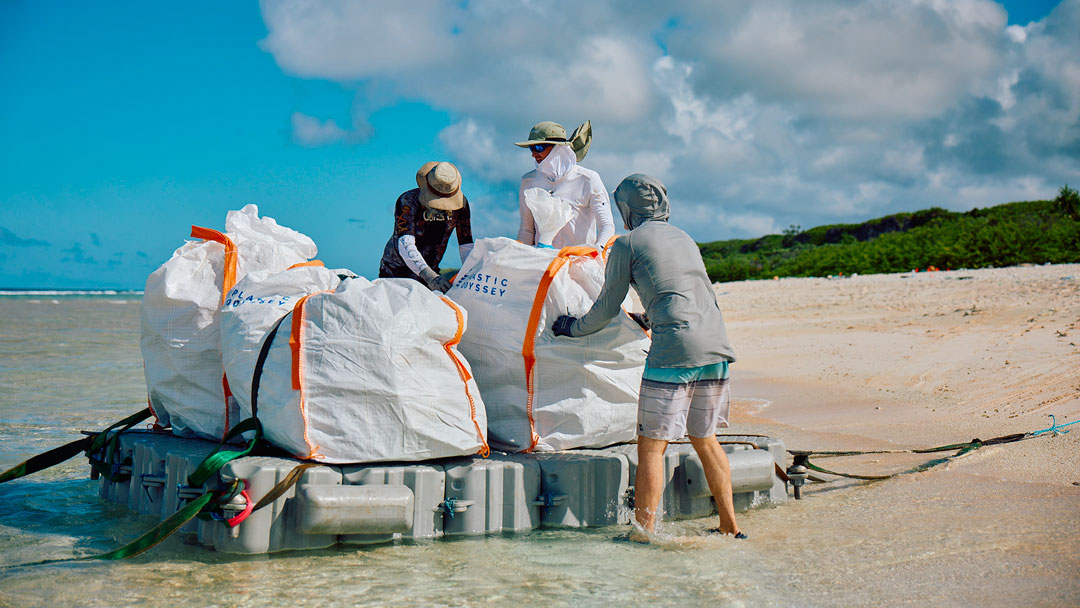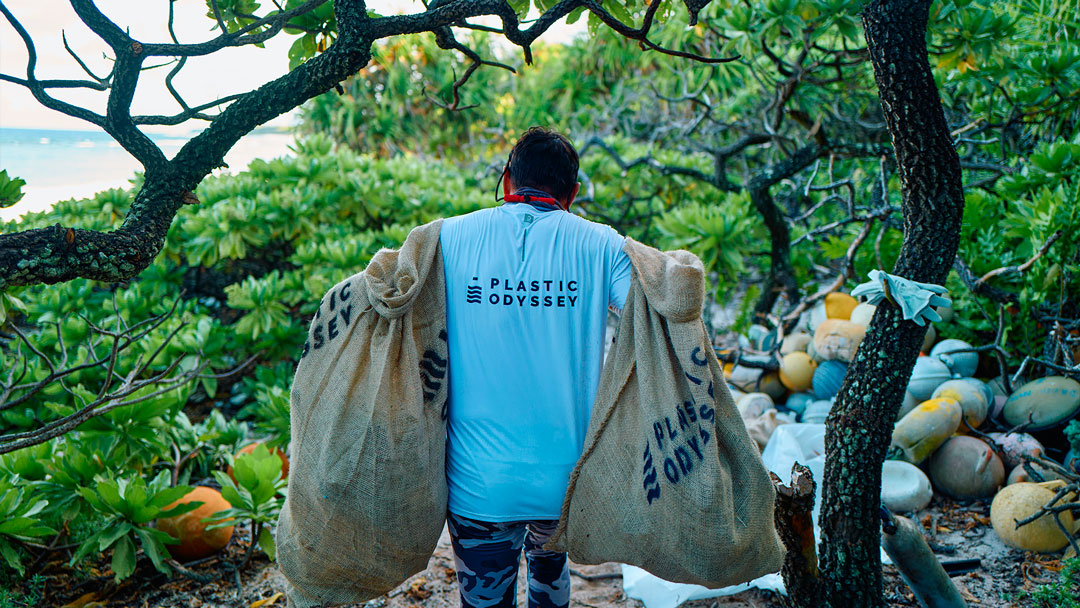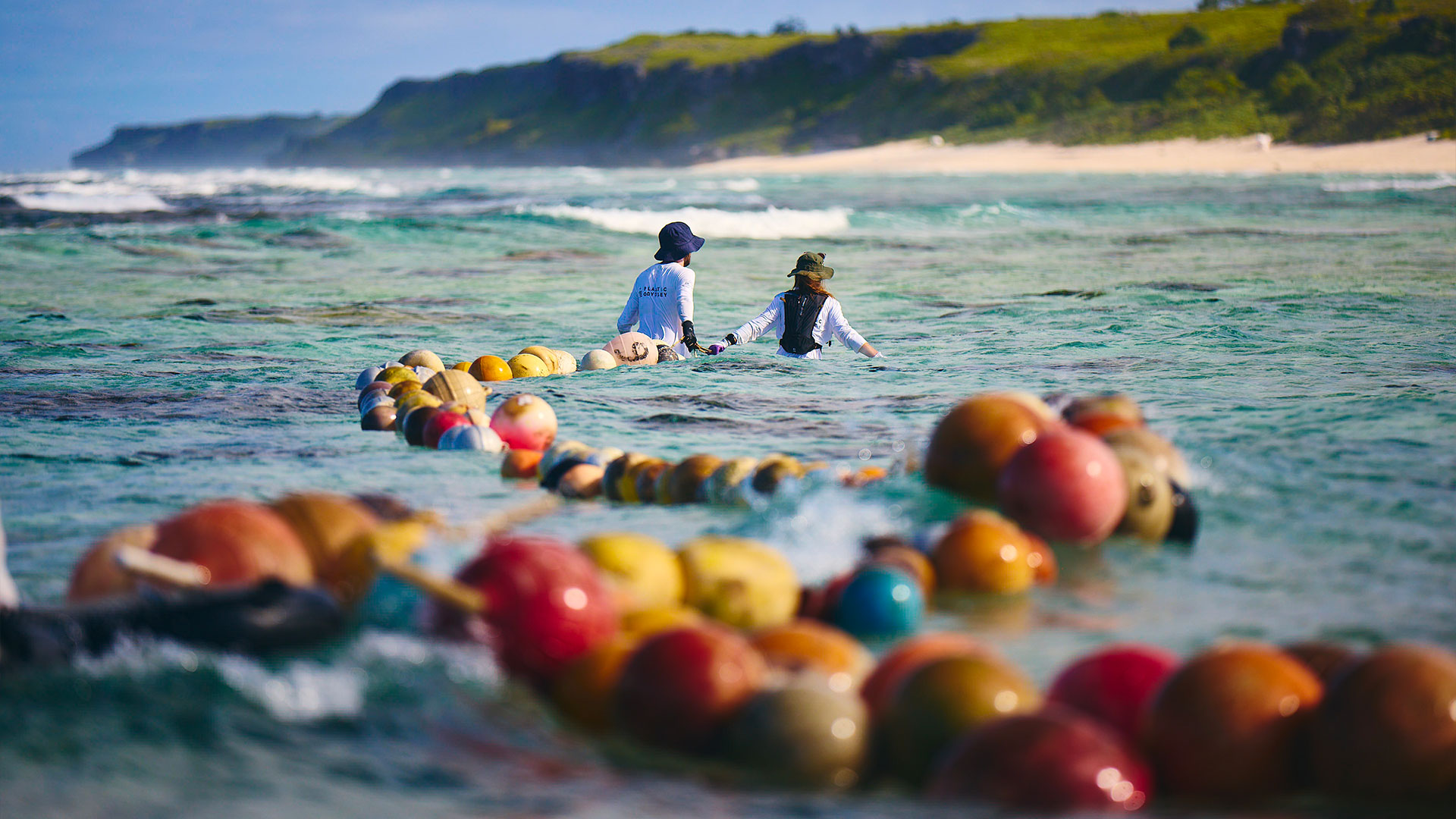
Operational from 6 in the morning, we start working before the sun overwhelms us. By 7 o’clock, the temperature rises sharply and becomes almost unbearable.
Today, we are focusing on the repackaging operation, which involves putting the old fishing nets gathered in 2019 into new big bags. These fishing nets are much heavier than hard plastics, making it more challenging to move the bags once filled.

The beach is over 2 km long, and we have only one possible crossing point to pass through the reef: the narrow passage that allows us to dispose of the waste. Even with our barge system, it’s a true challenge to tow the convoy from South to North or from North to South in the 50 cm of water covering the coral plateau just meters from the shore. In this trial, Baptiste and Maxime have become specialists. They traverse the beach without ever stopping, loading and unloading bags filled with sorted waste, each weighing an average of 100 kg.
These net bags are extremely heavy and bulky. We won’t be able to recycle them on board, just like the buoys, which are mostly still in good condition and will not be crushed or transformed. For these two types of waste, we have a solution: entrust them to the New Zealand ship that is supposed to pass by in 24 hours to help us transport a portion of the waste to Pitcairn, where we will meet in a few days. So, we move forward with this hope despite the accumulating fatigue and the frustration generated by the feeling that things are progressing much too slowly.
The bags accumulate at the crossing point. Hundreds of buoys pile up in various areas of the beach. We unearth them from the top of the shore to tie them together using ropes found on the beach. In 2019, 1200 buoys were counted. Today, we count more than 1,500. The formed garlands literally cover the shore. We tangle our feet in them, and our legs collide with the heavy buoys violently displaced by the waves.
In addition to buoys and heavy plastic waste bags, Hanna conducts scientific surveys in a “preserved” part of the beach. It is considered “preserved” because we are not allowed to collect waste there until the protocol is fully completed. Hanna performs “transects” (surveys along a line perpendicular to the shore and at various locations) and “quadrants” (measurements and classification of macro and microplastics on several 1-square-meter surfaces in the sand). To complete this protocol, we record the positions of several debris intentionally left by other scientists during previous expeditions to study their potential movement on the beach over the years. Five years later, a treasure hunt is underway to find these 15 objects. Half are found exactly in the same place; the rest have disappeared (disintegrated or carried away by waves or rare visitors). The island is an eternal tomb for the waste that reaches here. A scientific publication is planned to detail the results of these measurements (coming soon!). It was unimaginable to spend 7 days on this unique island without contributing to the scientific research that few data currently document.
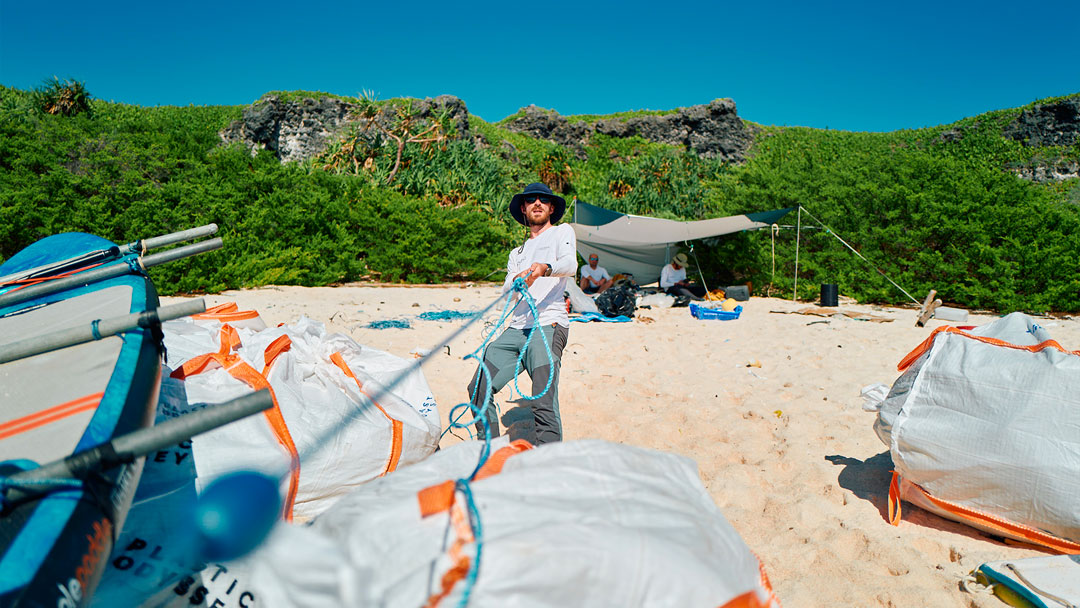
At noon, a well-deserved break in the shade of our camp revitalizes our energy and motivation. We will be able to extract some big bags filled with hard plastic waste, which we will transform directly on board our floating workshop. In a few hours and after three round trips with our platform system, we manage to remove 12 big bags of plastic from the beach. A small victory for a long day that is far from over. Because after the nets and buoys, we tackle the DCPs (floating rafts made of bamboo or PVC tubes dragging nets and ropes designed to create surface life ecosystems in the middle of the ocean). The DCPs are released and traced by fishing vessels but sometimes left abandoned. Henderson Island is located in the middle of one of the world’s most extensive protected areas. Fishing is not allowed within 200 nautical miles of its shores. These DCPs have traveled a lot. Each one weighs about 200 or 300 kg, and they need to be cut with a knife one by one. The nets, left in the sun for too long, scatter into small pieces when we cut them. Retrieving and sieving the sand is a step that is often added and makes the work even longer. It’s a new physical ordeal that finishes exhausting us. But by nightfall, everything is ready to load onto the Silver Supporter upon its arrival tomorrow. And the tally of this third day spent on the island is enormous:
- 1,500 buoys are gathered at the crossing point.
- 1.5 tons of nets are packed in waterproof big bags ready to board the Silver Supporter.
- 13 Big Bags of recyclable plastic have been transported on board the Plastic Odyssey.

Our raft system is operational and proves to be essential: we realize that the cyclone that delayed us in Mangareva a few days before departure has indeed been beneficial. Without it, we certainly would not have prepared them before arriving!
Around a revitalizing dinner illuminated by headlamps, we view the beautiful photos that Olivier was able to capture in these last few days, and it lifts our spirits. We share some images and the account of these recent days on board so that Marc and Alex can quickly publish updates on the progress of the mission.
During dessert, we open the can of freeze-dried food sent by our chef, Aodren. A surprise is hidden inside: freshly baked cookies that unanimously delight the camp. With smiles on our faces, each person heads to their tent for a well-deserved night of rest.
Other news
Days 9 & 10: Transformation of Plastic Waste
After spending a week on Henderson extracting tons of plastic waste polluting the island, we set sail as night falls. Heading towards Pitcairn Island....
Days 7 & 8: Last Days on Henderson
In the early hours of the morning, we traverse the long kilometer to the southern end of the beach, laden with water and empty Big Bags to commence the last waste collection....
Day 6: Crossing the Coral Reef by Air
Today is Sunday, and we're trying to mark the occasion by treating ourselves to a lie-in. A few hours of free time: some go for a run, others explore the extremities of the beach....
Day 5: First Parachute Trials
The usual rhythm takes shape: by 6 o'clock, most team members are already operational. This morning marks the beginning of the major collection!...
Day 4: Arrival of the Silver Supporter
If the Silver Supporter keeps its promise and joins us today, it could save us from a complex logistical problem by retrieving a significant portion of the heaviest bags....
Day 3: The cleanup is intensifying
Operational from 6 in the morning, we start working before the sun overwhelms us. By 7 o'clock, the temperature rises sharply and becomes almost unbearable....
Day 2: First Waste removal
The sun has risen on the East beach of Henderson Island, where 12 of us have spent the first of our seven days on site. As quickly as possible, to escape the scorching sun, we spread out along the entire length of the beach and begin gathering the Big Bags....
Day 1: Installation and launch of the cleaning operations
After a first night off the coast of Henderson Island, the Plastic Odyssey teams gather early to set foot on the East beach of the island. Today's missions: set up the camp, carry out surveys, and test the systems for transporting plastic waste packaged in Big Bags......
First steps on Henderson Island, covered in waste
On Monday, February 12, 2024, the Plastic Odyssey vessel and the expedition crew arrived off the coast of Henderson Island. Circling the island from its southern side and taking advantage of favorable navigation conditions....
